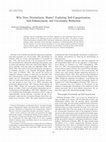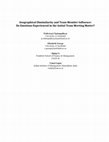Papers by Prithviraj Chattopadhyay
SSRN Electronic Journal, 2010
We argue that, when status differences between lower- and higher-status team members are well est... more We argue that, when status differences between lower- and higher-status team members are well established, intergroup relations are driven by status competition among higher-status team members and collaboration among lower-status team members. Supporting these arguments, we found that higher-status team members facing higher levels of professional dissimilarity (i.e., working with higher proportions of lower-status team members) reported fewer instances in which colleagues accused them of incompetence or breached norms of professional conduct; the latter resulted in lower levels of negative emotions and negative behaviors. Lower-status team members reported higher levels of these outcomes when working with higher proportions of higher-status team members.

61st Annual Meeting of the Academy of Management, 2001
Although relational demographers have based their arguments on self-categorization theory, they h... more Although relational demographers have based their arguments on self-categorization theory, they have paid little attention to the underlying processes associated with this theory. The authors examined whether demographic dissimilarity affects individuals' identification with groups by affecting the group's prototype valence and clarity and the individual's perceptions of self-prototypicality. The data showed that the proportion of women and non-Australians in 34 work groups negatively influenced prototype valence, prototype clarity, and self-prototypicality for all members of the group. These results provide support for the continued use of self-categorization theory by relational demographers. Diversity in the workforce has attracted a great deal of attention from both researchers (see Tsui & Gutek, 1999, and Williams & O'Reilly, 1998, for reviews) and practitioners (cf. Fernandez & Barr, 1993). One reason for this is the increasing level of workforce participation by traditionally underrepresented groups, such as women and minorities, both in the United States (Buhler, 1997) and in Australia, where this study was undertaken (Hede, 1995; Smith, 1998). One stream of research examining the consequences of workforce diversity is the relational demography approach (Tsui, Egan, & O'Reilly, 1992). This research has focused on employees working in groups in which they are dissimilar from their work-group peers on key demographic characteristics such as gender and race (demographic dissimilarity) and the resulting effect on work-related outcomes such as commitment, absenteeism, and intention to leave (

Journal of Applied Social Psychology, 2022
Gender bias against female leaders suggests that female leaders are less accepted than male leade... more Gender bias against female leaders suggests that female leaders are less accepted than male leaders. Moreover, research has suggested that male subordinates are less willing to accept female leaders than their female peers. We propose that their unwillingness to accept a female leader’s influence may invite male team members to seek to develop their own influence within the team. Drawing on the theory of social self-regulation in relational demography, we argue that compared with their female counterparts, male team members are more motivated to increase their influence within the team through competence monitoring (self-regulated behavior to establish their competence within the team), especially when there is a greater proportion of male peers in the team (i.e., a lower level of gender dissimilarity between themselves and the rest of the team). In turn, we propose that competence monitoring has an increasingly positive relationship with the influence of male members within the team. The findings of our multisource survey of 288 members of 61 research and development teams supported our hypotheses. We discuss the implications of our findings for research on gender and leadership and relational demography.

We argue that the emotions team members experience in their initial team meetings moderate the ex... more We argue that the emotions team members experience in their initial team meetings moderate the extent to which their geographic dissimilarity impacts the extent to which they identify with the team and are perceived by teammates to influence team decisions over time. We consider these direct relationships at the beginning of the team project (T1) and after the project’s midpoint (T2). We tested our hypotheses on two samples. The first consisted of 204 members of 48 teams engaged in an ongoing MBA project in Hong Kong, and the second consisted of 444 members of 75 teams working on MBA projects in India. There was more consistent support for the hypotheses in the sample from Hong Kong but both samples showed that the effect of geographic dissimilarity on identification and influence at T2 was moderated by the emotions that individuals felt when they first encountered the group (T1). These findings shed light on the conditions under which dissimilarity in a group might have positive, o...
Managing emotions in the workplace, 2002
In this chapter, we propose a model of managerial intuitive decision making based on problem char... more In this chapter, we propose a model of managerial intuitive decision making based on problem characteristics, decision characteristics, environmental factors, and individual factors. We propose also that affect moderates the intuitive decision-making process. Based on the affect infusion model (AIM), we suggest three interaction scenarios between the determinants of intuitive decision making and affect: moderate mood, high-intensity emotions, and affective feelings. We theorize that positive mood encourages the use of ...
Academy of Management Journal, 2016
We examine changes in organizational identification among 1,346 newcomers at critical milestones ... more We examine changes in organizational identification among 1,346 newcomers at critical milestones during their first year. Integrating the social identity approach with the literature on psychologic...
Academy of Management Proceedings, 2015
We argue that the perceived prestige of an organization influences organizational identification ... more We argue that the perceived prestige of an organization influences organizational identification via perceptions of psychological contract breach over time. We examine changes in these variables du...
Human Rights Documents Online
The designations employed in ILO publications, which are in conformity with United Nations practi... more The designations employed in ILO publications, which are in conformity with United Nations practice, and the presentation of material therein do not imply the expression of any opinion whatsoever on the part of the International Labour Office concerning the legal status of any country, area or territory or of its authorities, or concerning the delimitation of its frontiers. The responsibility for opinions expressed in signed articles, studies and other contributions rests solely with their authors, and publication does not constitute an endorsement by the International Labour Office of the opinions expressed in them. Reference to names of firms and commercial products and processes does not imply their endorsement by the International Labour Office, and any failure to mention a particular firm, commercial product or process is not a sign of disapproval.
This paper reviews a stream of research that examines the processes underlying effects related to... more This paper reviews a stream of research that examines the processes underlying effects related to demography and demographic differences. Three broad areas of research are discussed: (i) research examining whether differences in functional experience have an effect on how individuals view and interpret situations, (ii) research that examines whether and how dissimilarity in terms of demographic characteristics such as functional background, race, sex and age influences interpersonal dynamics and individual attitudes and behaviours, and (iii) research examining if effects related to work status dissimilarity parallel those of other demographic variables. We conclude with a discussion of avenues for future research, and managerial implications of this research. Keywords: DEMOGRAPHIC DISSIMILARITY.

This study attempts to reconcile previous findings that show both positive and negative outcomes ... more This study attempts to reconcile previous findings that show both positive and negative outcomes associated withblended workgroups (i.e., workgroups consisting of both temporary and standard workers). Specifically, we concep-tualize temporary and standard work as part of a naturally occurring status hierarchy in organizations and propose that blended workgroups have opposing effects on employees depending on employees ’ perceptions of their potential for upward mobility in that organization. We combine research on the blended workforce with theorizing from social identity and self-categorization theories to propose that when employees perceive the potential for upward mobility to be high, the proportion of temporary workers in the group will be negatively related to employee attitudes and behaviors, and the relationship will be positive when perceived mobility is low. Furthermore, we hypothesize that this relationship will be mediated by the valence of employees ’ perceptions of the...
Australian Journal of Psychology, 2002
skip nav. ...

Academy of Management Proceedings
An important challenge that women more than men face in gender diverse teams is how to build up i... more An important challenge that women more than men face in gender diverse teams is how to build up influence within the team. To address this issue, we draw on the social identity perspective and status characteristics theory and integrate two isolated streams of research in relational demography about member-member gender dissimilarity and member-leader gender dissimilarity. We argue that dissimilarity to team and dissimilarity to leader interact to convey status signals that have different implications for men and women. For men, gender dissimilarity was predicted to be more negatively related to competence monitoring with a gender-dissimilar leader, whereas for women gender dissimilarity was predicted to be less negatively related to competence monitoring with a gender-dissimilar leader. Competence monitoring was proposed to have an increasingly positive curvilinear relationship with influence within the team. Multilevel moderated mediation analysis of multiple-source data from a sample of 288 employees i...
Sinclair, M., Noordink, P., Ashkanasy, NM and Chattopadhyay, P. (2000). Measuring intuitive abili... more Sinclair, M., Noordink, P., Ashkanasy, NM and Chattopadhyay, P. (2000). Measuring intuitive ability using AIM : Scale reliability and relationships with measures of emotion. In: W. Noble, Australian Journal of Psychology: Combined Abstracts of 2000 Australian Psychology Conferences. The 5th Annual Meeting of the Society of Australasian Social Psychologists, Fremantle, Western Australia, (17-17). 27-30 April 2000. ... Sinclair, M. Noordink, P. Ashkanasy, NM Chattopadhyay, P.
Academy of Management Proceedings
Diversity scholars have highlighted that the climate for inclusion is imperative for diversity ma... more Diversity scholars have highlighted that the climate for inclusion is imperative for diversity management. However, we know little about how climate for inclusion affects individual performance. Ba...







Uploads
Papers by Prithviraj Chattopadhyay